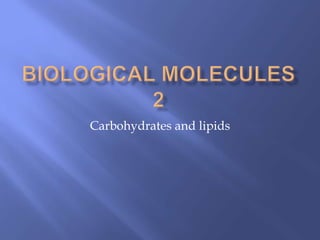
Carbs Lipids Structures Properties
- 1. Carbohydrates and lipids Jorge Melo
- 3. High specific heat capacity. High latent heat.
- 5. Hydrolysis Condensation
- 10. List the features of carbohydrates. Using diagrams to explain the structure of a simple carbohydrate. Explain how complex carbohydrates are formed from simple carbohydrates. List the differences between triglycerides and phospholipids. Describe the structure of lipids. Explain how the structure of lipids affects their properties.
- 11. Carbohydrates Disaccharides Polysaccharides Lipids Triglycerides Phospholipids Cholesterol
- 12. Most important source of energy Store energy Make structure Elimination of waste materials and toxins Sources: dairy products, fruits and sugar (simple) starches are found in grains or cereals such as rice, barley, oat, buckwheat, millet and rye, and in some root vegetables including parsnips and potatoes (more complex).
- 13. Carbon Hydrate Carbon and water 3 atoms C O H
- 14. Three types of carbohydrates Monosaccharides (simple sugars) Disaccharides (double sugars (form from two monosaccharides) Polysaccharides (polymer chain – hundreds of monosaccharides)
- 15. Carbohydrates are made up of sugar molecules, the general formula for sugar is CnH2nOn. A carbohydrate that is a single sugar molecule is a monosaccharide. Examples include glucose, fructose, and galactose. As sugars monosaccharides are all sweet. Glucose is an example of a Hexose, and has two forms alpha and beta.
- 16. The name of monosaccharides varies with the number of C atoms 3C Trioses 5C Pentoses 6C Hexoses
- 17. Main energy source for most living organisms Photosynthesis product Structural isomers α 1-4 linkages: starch (amylose and amylopectin) easy to break down by enzymes β 1-4 linkages: linear microfibrils of cellulose difficult to break down
- 18. Fructose Very sweet sugar Galactose Found on milk Galactose
- 19. Made by joining two monosaccharides. Two α glucose molecules form maltose. condensation reaction. glycosidic bond (covalent) Because the link is between carbon 1 and 4, it’s an α 1-4 glycosidic bond. Disaccharides are also sweet.
- 20. Sucrose: the sugar you put in your tea lactose: milk sugar
- 21. Using the diagram on the previous slide work out the formula for maltose. C12H22O11
- 22. What name is given to the carbohydrate in which n is 6 5 3 State 2 different functions of the carbohydrates Simple carbohydrates are combined to form disaccharides, what else is produced?
- 23. Maltose is broken down by the enzyme maltase. This is a hydrolysis reaction.
- 25. Linking together thousands of α glucose molecules produces amylose found in starch. Amylose molecules coil to form long spirals held in place by hydrogen bonds, making it compact. Starch is insoluble and metabolically inactive making it perfect for storing in plant cells. It is not sweet.
- 26. Animals do not store amylose, instead they use glycogen which is similar but contains 1-6 glycosidic bonds forming side branches. Glycogen is broken down by the enzyme glycogen phosphorylase which is activated by insulin.
- 29. Cellulose is similar to amylose but it is made of β-glucose, the β 1-4 bonds do not cause it to coil instead it is straight. As a result the molecules do not form hydrogen bonds within the same strand but with their neighbours forming bundles called fibrils which in turn for larger bundles called fibres all held by hydrogen bonds. This makes cellulose extremely strong, and there are very few animals with enzymes to break β 1- 4 bonds.
- 31. Fats and oils Room temp. fats are solids, oils are liquid Made of: C O H Higher proportion of H Insoluble in H2O
- 32. Simplest example of a lipid 3 fatty acids attached to a glycerol molecule
- 33. The carboxyl group at the end of the fatty acid reacts with the hydroxyl group on the glycerol. Forming an ester bond, (involves covalent bonds). This is a condensation reaction Ester bond
- 34. Insoluble in H2O – no charge Hydrophobic Saturated (where each of the carbons in the fatty acid are attached to two hydrogen atoms.) Unsaturated (double bonds)
- 36. Like a triglyceride but one of the fatty acid chain replaced by a phosphate group Different properties Head hydrophobic Tail hydrophilic Blue: Fatty acid Pink: Glycerol Yellow phosphate group
- 37. Basic form of the cell membrane
- 38. Cholesterol is very different from other lipids, some don’t class it as a lipid at all. This basic structure is shared with all steroids that are made from it, many of which are hormones.
- 41. List the features of carbohydrates. Using diagrams explain the structure of a simple carbohydrate. Explain how complex carbohydrates are formed from simple carbohydrates. List the differences between triglycerides and phospholipids. Describe the structure of lipids. Explain how the structure of lipids affects their properties.
